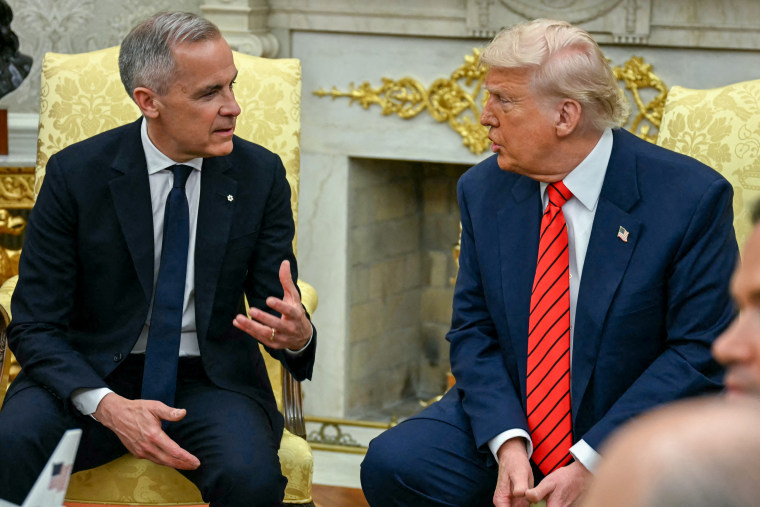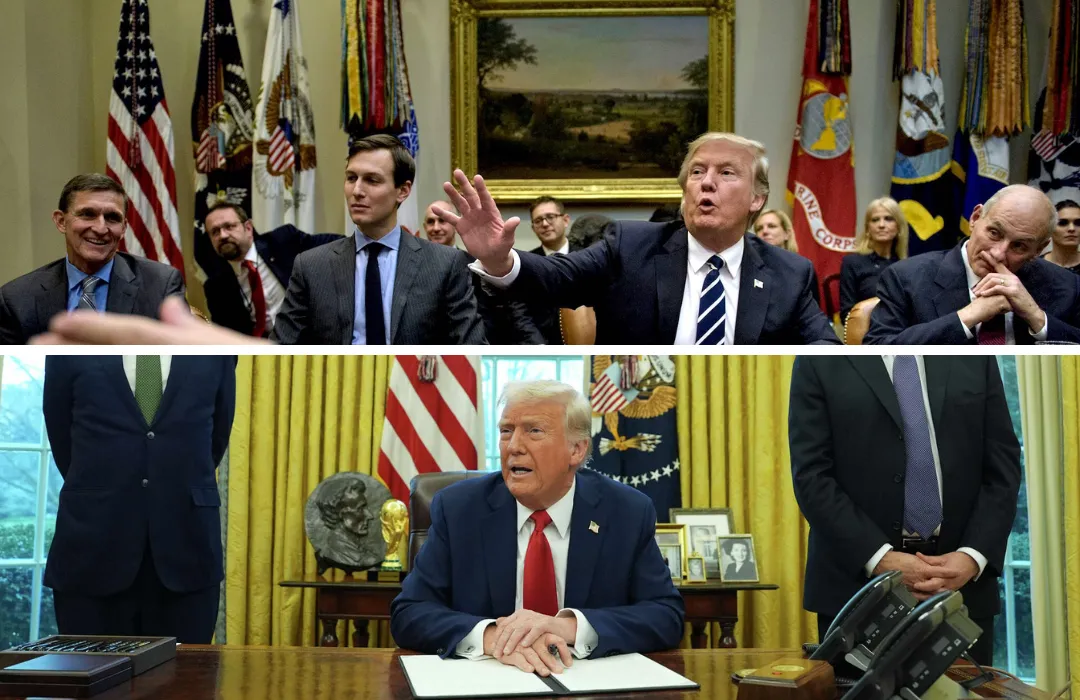
In a bold and controversial move, President Donald Trump has announced an escalation of tariffs on Canadian imports, raising them from 25% to 35%.
This drastic measure, effective Friday, is aimed at holding Canada accountable for its failure to curb the flow of fentanyl and other illicit drugs, which have been flooding into the U.S. from its northern neighbor.
The White House’s new directive marks a significant step in the president’s ongoing effort to use tariffs as a tool to address national security concerns and to push for fairer trade deals.
On Thursday, the White House released a statement confirming that President Trump had signed two major executive orders to modify tariffs on foreign goods, including the Canadian tariff hike.
The main justification for these changes, according to White House officials, is Canada’s failure to prevent the entry of illicit drugs such as fentanyl into the United States.
As part of this new tariff structure, Trump signed an executive order that effectively punishes Canada for being a key part of the drug trade network.
The U.S. government has long accused Canada of allowing Mexican drug cartels to operate freely on its territory, with fentanyl and other dangerous synthetic opioids reaching U.S. communities.
Trump and his team have made it clear that this tariff increase is an attempt to force Canada to take stronger action against these drug trafficking operations.

The White House statement called the new tariff a necessary measure to protect U.S. national security and ensure a fair and balanced trade relationship.
This marks the latest chapter in the U.S.-Canada trade tensions, which have already seen ongoing disputes over steel, aluminum, and agricultural products.
However, this new tariff specifically targets the flow of illicit drugs, and the White House has made it clear that it is using trade negotiations to enforce stricter drug control measures.
Fentanyl, a powerful synthetic opioid, has been responsible for thousands of overdose deaths in the U.S. in recent years.
With an estimated 74 pounds of fentanyl seized at the northern border by U.S. Customs and Border Protection (CBP) in fiscal year 2025, this issue has become a national crisis.
Many of these drugs are believed to be manufactured in “super labs” located in Canada, a disturbing revelation that has sparked anger from U.S. authorities.
According to Trump’s administration, Mexican drug cartels are operating fentanyl and nitazene-synthesis labs in Canada, allowing the deadly drugs to flood across the U.S.-Canada border.
Some of these labs, which are reportedly located in rural and remote areas of western Canada, can produce between 44 and 66 pounds of fentanyl every week.

This large-scale production of synthetic opioids has contributed to the growing number of overdose deaths across the United States, leading the Trump administration to escalate its actions against the Canadian government.
The president’s claim that drug trafficking organizations based in Canada operate with impunity highlights the U.S.’s frustration with its northern neighbor’s efforts to address the growing opioid crisis.
Critics have also pointed out that these fentanyl shipments often originate from China, further complicating the fight against illicit drugs.
This tariff increase is not the first time President Trump has used trade to exert pressure on Canada.
In previous years, Trump has imposed tariffs on Canadian steel and aluminum, citing concerns over unfair trade practices and the need to protect U.S. industries.
These tariffs were met with retaliatory measures from Canada, which imposed its own tariffs on U.S. goods, including products like dairy, agricultural products, and industrial goods.
In addition to these sectoral tariffs, the U.S. and Canada have been at odds over a variety of trade issues, with both countries frequently accusing each other of unfair trade practices.
The relationship has been strained further by Canada’s decision to impose tariffs on U.S. steel and aluminum products, which Trump says hurt American workers.

Despite the animosity, Canada remains one of the U.S.’s largest trading partners. The new 35% tariff, however, represents a significant escalation in the trade war.
This tariff increase comes on top of other recent tariff hikes imposed by the Trump administration on various nations, especially those with large trade deficits with the U.S., such as China, Mexico, and several European countries.
The Canadian government has expressed strong opposition to the latest U.S. tariff hike.Doug Ford, the Premier of Ontario, condemned the move in a tweet, calling the tariff increase “concerning” and emphasizing the importance of standing firm in the face of what he described as unfair treatment.
Ford pointed out that while Canada still benefits from zero tariffs on most of its trade with the U.S. under the United States-Mexico-Canada Agreement (USMCA).
This tariff hike could have devastating consequences for Canadian businesses, particularly those involved in industries like steel, aluminum, and automotive manufacturing.
Ford suggested that Canada should respond by implementing a 50% tariff on U.S. steel and aluminum, signaling that his government is prepared to retaliate against the U.S. action. “Canada has what the United States needs: oil and gas, critical minerals, steel and aluminum, electricity, potash, and uranium,” Ford stated.
He added that Canada is America’s number one customer, and the country’s exports sustain millions of American jobs.
Ford’s response reflects the sentiment of many Canadian leaders who feel that their country is being unfairly targeted in this trade dispute. Canada’s economic interdependence with the U.S. means that tariffs can have a significant impact on both sides, making retaliation a likely scenario.

While Ford and others are advocating for strong countermeasures, the Canadian federal government has also stressed the importance of working together with the U.S. to resolve trade issues and ensure a fair trade relationship.
However, Canada is also determined to protect its workers and industries from the negative impacts of President Trump’s trade policies.
In response to potential Canadian retaliation, the Trump administration has reiterated that its tariff policies are designed to protect U.S. industries and reduce trade deficits.
Trump has consistently argued that many of the U.S.’s trade deficits are unsustainable and pose a threat to national security. By imposing higher tariffs on goods from countries with large trade deficits, the U.S. aims to level the playing field and encourage these countries to make concessions in trade negotiations.
In addition to the tariff hikes on Canada, Trump’s executive orders have included measures targeting other countries with whom the U.S. has trade deficits.
Among these countries are Syria, Myanmar, Laos, Switzerland, and several others, with tariffs ranging from 30% to 41%. These measures reflect the administration’s broader approach to trade, which aims to prioritize American interests and national security above all else.
The use of tariffs as a tool to protect national security and address trade imbalances is central to President Trump’s “America First” agenda.
The administration has consistently argued that the U.S. has been taken advantage of in international trade agreements and that its economic interests have been sidelined in favor of other nations.

Through tariff increases and new trade deals, Trump aims to put American workers and industries at the forefront of U.S. policy.
While the long-term effectiveness of these tariffs remains uncertain, they have already sparked significant controversy both domestically and internationally.
As the trade war between the U.S. and Canada continues to unfold, both nations will have to navigate a complex web of economic and political factors to avoid further escalation and to ensure that their respective economies can continue to thrive despite the tensions.
For now, President Trump’s decision to increase tariffs on Canada to 35% signals a tough stance on illicit drug trafficking and a broader attempt to overhaul the U.S.'s trade relationships globally.
Only time will tell if this strategy will yield the desired results, or if it will lead to further retaliation and economic uncertainty.



